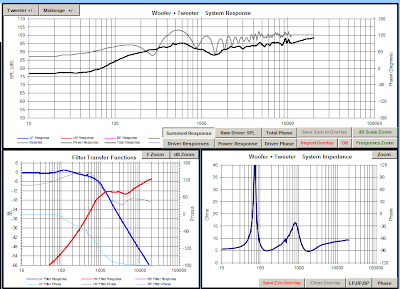To do that, I started over with a much larger inductor on the low pass filter, which essentially lowered the cuttoff frequency, but since the response was rising for the woofer anyway I was able to end up with about the same crossover frequency as before.
Unfortunately, this decreases the overall sensitivity of the speaker, but I was willing to make that sacrifice for a more balanced frequency response.
Here is the circuit that I came up with for the crossover:
It is a third order low pass on the woofer, with a first order high pass on the tweeter. The capacitor and resistor in parallel on the high pass make up an RC contour filter which adds a rising response to the upper frequencies. This was added to get a little bit more high frequency extension out of the tweeter which rolls off a little early (15kHz or so) on its own. Finally, the series RLC circuit in parallel with the tweeter is a simple notch that is made to knock down a bump around 4kHz and flatten out the tweeter's response overall.
Below are measurements taken indoors at about four feet away. First is the horizontal off axis performance:
Next is the vertical off axis performance:
The hump at about 500Hz, and the dip at 225Hz both seem to be room related, since they appear in measurements of other speakers as well. I'll take some measurements outside when I get a chance.
Once the crossover design was finalized I ordered the parts, built up the crossovers, and installed them in the cabinets.
Above is the finished crossover, and below are the before and after pictures of the speakers in their final resting place in my current space. I'll put the third one to use once I move to a larger space.
The sound is phenomenal. These speakers don't even break a sweat at levels that will drive me out of the room, and the higher sensitivity means that my amplifier doesn't have to work as hard to do it. The added sensitivity and lower distortion also make them easier to listen to without discomfort at higher levels. Overall I'm very impressed, and glad to be enjoying these speakers that I've been working of for about eight months.
Many thanks to EricH of DIY Sound Group, as well as tuxedocivic and BWaslo of the AVS forums. Without their parts and assistance, this project wouldn't have happened.
















